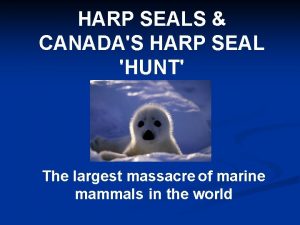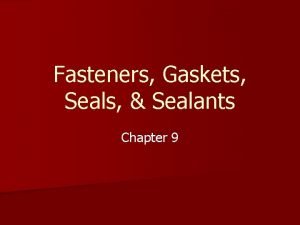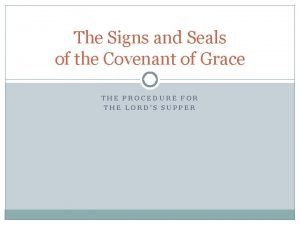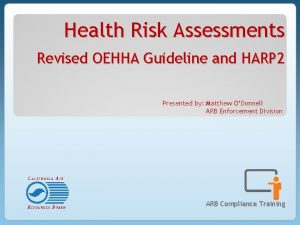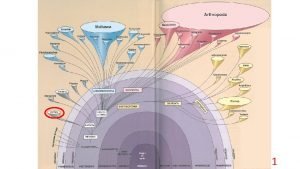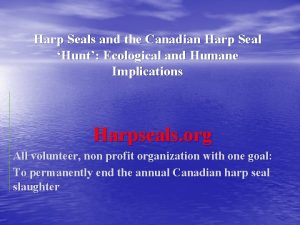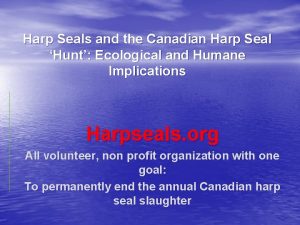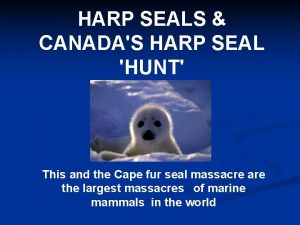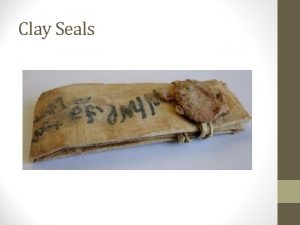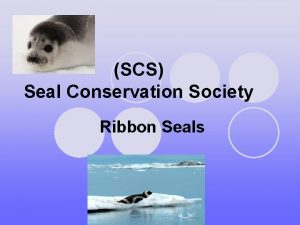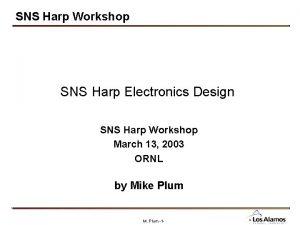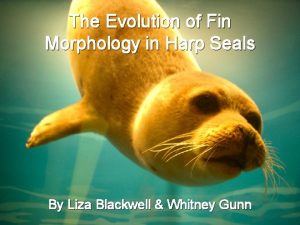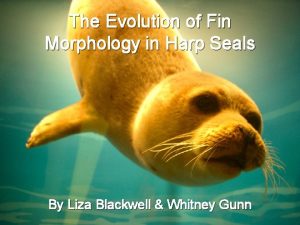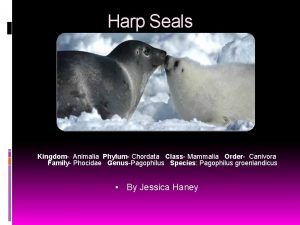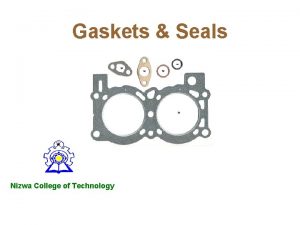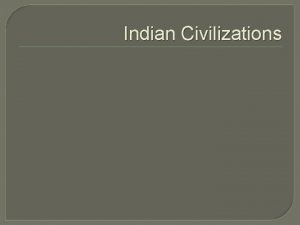Conservation of Harp Seals and the Canadian seal




















- Slides: 20

Conservation of Harp Seals and the Canadian seal hunt By Haylie Cox and Steffani Geary

About the seal • Ice flows are essential to the breeding and nursing of seals. – Because of ice decreasing, the percentage of pregnant females dropped from 90% in the 1980’s to 70% in the 1990’s. • Diet consists of polar cod, herring, halibut and small crabs. – Polar cod are now listed as endangered • Male reach sexual maturity around 7 -8 years of age, females around 4 -6 years. – Current population is about 5. 8 million worldwide – Pups produced yearly is about 991, 400 in Canada

Overview of the hunt • Each year, Canadian fisherman kill hundreds of thousands of Harp Seals. • Harp Seals are targeted between the ages of 2 weeks and 2 -3 months. (it’s now “illegal” to kill them before 12 days of age) • The biggest controversy surrounding the hunt is the method with which they are killed. – They are clubbed, hooked, and dragged. – Many are still alive and conscious during the skinning process, despite what Canadian officials claim.

This year’s hunt • Quota for 2009 was set at 280, 000 • Fisherman who did not meet their quota in 2008 are allowed to kill an additional 13, 095 pups • 30% of pups will be killed in the Gulf of St. Lawrence, where concern has been expressed about diminishing ice flows. – Gulf of St. Lawrence is also one of the main birthing grounds in Canada.

Gulf of St. Lawrence • Gulf of St. Lawrence is one of the main birthing/nursing grounds in Canada. • Remember, 30% of the seals of the seal hunt are killed at the Gulf of St. Lawrence. • With that in mind: – Pup mortality: 220, 000 pups died due to poor ice conditions in 2006 (75% mortality rate for 12 days of age and under) – Ice conditions are worsening. – If ice conditions continue to worsen, there will be 100% pup mortality rate.

Gulf of Lawrence • Canada continues to oppose the findings of scientists: – Pup production is low, but they believe it to be scientists’ bias. – “Ice conditions in the North Gulf are better than ever, so there is no reason to think that it would have a high pup mortality in the future. ”



Canada’s conservation management plan • Set up by the Fisheries and Oceans Canada. • The plan is called the “Precautionary Approach, ” and its objective is to keep the population around 80% of its current numbers. – This is why the quota for Total Allowable Catch (TAC) is 250, 000 -280, 000. – Populations are monitored every 5 years. • Current management results in a low probability that human-induced mortality will cause the stock to decline below that level. –Canadian government

Scientists disagree • “The current monitoring scheme is unlikely to detect management failure until a large proportion of the population is lost. ” • The management plan doesn’t account of the struck-and-lost seals. – For every 1 seal that is killed and reported, it is estimated that almost one (0. 82) is lost and unreported, which would result in an additional 45% over the TAC. • “Even if Canada lowers their TAC, it’s unlikely they will achieve their current conservation objective. ”

Canadian Government • Populations only surveyed every 5 years • Maintain that killing practices are humane • Deny any stuck-andlost and illegal activity • Illegal activity (killing before 12 days old, etc. ) is recorded, but fishermen aren’t held accountable for it VS Scientists, Organizations • Struck-and-lost taken into account • Has been shown that some are alive and conscious when they’re skinned • Scientists have estimated struck-andlost at 45% over the TAC , which almost doubles the total allowable killed


• • • Raw Data TAC 2009 was 280, 000 Scientist estimate struck and lost at 0. 82 280000 x 0. 82 = 229, 600+280, 000 509, 600 Lets add in 220, 000 harp seal pups that died due to ice conditions 729, 600 total pups lost There were 991, 400 pups born in Canada in 2006, lets say the pup population has increased and 1, 000 pups were born this year 1, 000 -726, 600 = 273, 400 Probability half will be females 273, 400/2 = 136, 700 females Scientist estimate that only 70% of females are giving birth due to poor ice conditions 136, 700 x 0. 70 = 95, 690 possible births Does this look like Canada is following their management plan? ? ?




Civic Engagement • Encourage stores, restaurants, etc. to boycott Canadian Seafood. • Write public officials to: – Put pressure on Canada to stop the hunt, or lower quotas. – Persuade Canada to use more humane ways of acquiring fur (“combing”). – Have Fisheries and Oceans Canada set up a better management plan that is followed and met! • Education

Organizations • If you would like more information about the Canadian seal hunt, or to find out how you can help, you can visit these organizations: – Greenpeace – Harpseals. org – PETA – Humane Society


• • • References www. greenpeace. org www. harpseals. org www. hsus. org http: //www. dfo-mpo. gc. ca/media/npress-communique/2009/hq-ac 07 eng. htm http: //marinebio. org/species. asp? id=302 http: //www. pinnipeds. org/species/harp. htm DFO. 2000. Northwest Atlantic Harp Seals. DFO Science Stock Status Report E 101 (2000). Johnston, D. W. , Meisenheimer, P. , and Lavigne, D. M. (2000). An Evaluation of Management Objectives for Canada’s Commercial Harp Seal Hunt, 1996 -1998. Conservation Biology, 14 (3): 729 -737. DFO, 2007. A Review of Ice Conditions and Potential Impact on Harp Seal Neonatal Mortality in March 2007. DFO Can. Sci. Advis. Sec. Sci. Resp. 2007/008. Lairdre, Kristin L. , Stirling, Ian, Lowry, Lloyed F. , Wiig, Oystein, Heide. Jorgensen, Mads Peter, and Ferguson, Steven H. (2008). Quantifying the Sensitivity of Arctic Marine Mammals to climate-induced habitat change. Ecological Applications, 18(2): S 97 -S 125. Lavigne, David M. (1999) Estimating total kill of northwest Atlantic harp seals, 1994 -1998. Marine Mammal Science, 15 (3): 871 -878. Leaper, R. and J. Matthews (2008). Implications of uncertainty for Canada’s commercial hunt of harp seals (Pagophilus groenlandicus ). Nature Precedings 1798(1): 1 -23.
 Harp seals life cycle
Harp seals life cycle Harp and bowl worship
Harp and bowl worship Sonata for harp and bicycle
Sonata for harp and bicycle Sonata for harp and bicycle characters
Sonata for harp and bicycle characters Fasteners gaskets seals and sealants
Fasteners gaskets seals and sealants Fasteners gaskets seals and sealants
Fasteners gaskets seals and sealants Automotive bearings and seals
Automotive bearings and seals Signs and seals of the covenant
Signs and seals of the covenant Cci pipeline systems
Cci pipeline systems The mysteries of harris burdick a strange day in july
The mysteries of harris burdick a strange day in july Harp of india
Harp of india Afiw instrument classification
Afiw instrument classification Admrt
Admrt Chondrocladia lyra
Chondrocladia lyra Harris burdick the harp
Harris burdick the harp Jesse tree harp
Jesse tree harp Randy harp
Randy harp Caribbean cleaners national geographic
Caribbean cleaners national geographic So giant
So giant Heritage swim club
Heritage swim club Easter seals pei
Easter seals pei
